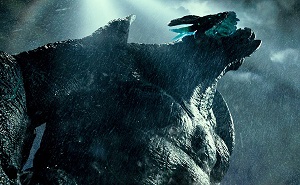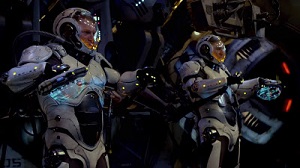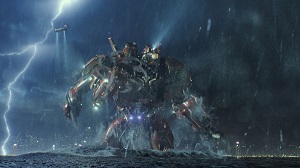Here’s my TV review with clips of Pacific Rim with Alexis del Cid on KCTV5′s It’s Your Morning.
 The original version of my full Pacific Rim print movie review is at Lawrence.com.
The original version of my full Pacific Rim print movie review is at Lawrence.com.
In the $180-million Hollywood behemoth Pacific Rim, “Kaiju” are giant monsters who come from the sea to wreak havoc and destroy entire cities.
It’s a direct tribute to the Kaiju genre of Japanese monster movies (that began with “Godzilla”) that director Guillermo del Toro has named these meticulously designed CGI creatures after the genre that inspired them, and that’s just the beginning of the references and shout-outs on display in Pacific Rim, which has enough bombast and vigor for 100 summer movies.
But it also has a firm grasp on what makes genre storytelling work, and it’s del Toro’s true love and respect for the Kaiju genre (and the tenets of a good action film) that holds Pacific Rim up, even in its most predictable moments.
The premise, as you may have already gathered from the film’s marketing, is simple: Giant robots battling giant monsters for the future of the planet. But two concepts immediately make that simple conceit more interesting right off the bat.
 First, Pacific Rim is not an origin story. In the 18-minute prologue — that’s how long it was before the film’s title appeared on screen — we are not only treated to a spectacularly mounted monster vs. robot fight scene with tragic consequences, but we get loads of background on this protracted war for Earth. The plot begins in earnest not with the ideation and construction of giant robots designed to save humanity, but with society’s abandonment of them.
First, Pacific Rim is not an origin story. In the 18-minute prologue — that’s how long it was before the film’s title appeared on screen — we are not only treated to a spectacularly mounted monster vs. robot fight scene with tragic consequences, but we get loads of background on this protracted war for Earth. The plot begins in earnest not with the ideation and construction of giant robots designed to save humanity, but with society’s abandonment of them.
This positions the flawed human warriors who pilot these giant robots (called Jaegers; German for “hunter”) not as worldwide heroes, but as underdogs fighting for our last chance at survival. The stoic, battle-hardened commander Stacker Pentecost (Idris Elba) is confident that he’s fighting the good fight, even if the rest of the world views he and the Jaegers as relics. In this way, the Jaeger pilots have the same “hero or menace” dilemma as most superheroes.
Co-writer/director del Toro gets so much exposition out of the way in the beginning that he allows the world of Pacific Rim to feel lived in, and the detailed production design and CGI work support that completely. It has the rain-soaked, near-fatalistic vibe of a film noir, with traces of the Asian-futuristic world of Blade Runner, and mecha anime.
 Secondly, the crux of the film is an emotional struggle. In order to pilot a Jaeger, two unique people must form a psychic bond through something called “The Drift.” Essentially, it’s a two-way mind-meld that opens all of your thoughts and past experiences up to another person in the hopes that the two will become one and be able to power the giant robot.
Secondly, the crux of the film is an emotional struggle. In order to pilot a Jaeger, two unique people must form a psychic bond through something called “The Drift.” Essentially, it’s a two-way mind-meld that opens all of your thoughts and past experiences up to another person in the hopes that the two will become one and be able to power the giant robot.
The most affecting scenes in Pacific Rim are the ones where former Jaeger pilot Raleigh Beckett (Charlie Hunnam) enters The Drift with an emotionally scarred Jaeger candidate named Mako Mori (Rinko Kikuchi). The visual representation of The Drift is as exciting as the emotional backstories of the characters involved, and that’s not something you can say for every action movie.
On a micro level, this idea that two very different people can join together to defeat a common foe against all odds is a well-worn one. Put in the proper perspective by the right filmmaker, however, it’s as good as gold. Super-size that sentiment on a global level with Russian, Chinese, Australian, Japanese and American pilots, scientists, and technicians all working together to the save the world and suddenly the corny becomes inspiring.
 The climax is similar to some other recent blockbusters (see The Avengers and The Dark Knight Rises), but at least it’s partially earned not just by beating the opponent to a pulp (see Man of Steel), but by a certain amount of cunning.
The climax is similar to some other recent blockbusters (see The Avengers and The Dark Knight Rises), but at least it’s partially earned not just by beating the opponent to a pulp (see Man of Steel), but by a certain amount of cunning.
Pacific Rim also has a good amount of comic relief (unlike Man of Steel), in the form of nerdy scientists Charlie Day and Burn Gorman, whose lightning-quick delivery is in sharp and funny contrast to black-market Kaiju organ-dealer (yes, you read that right) Hannibal Chau, played by genre stalwart Ron Perlman, who del Toro fans know especially know as the wise-cracking supernatural hellraiser Hellboy. It’s a subplot that’s needed not just from a plot standpoint, but it also mixes up the tone and shows that the movie doesn’t take itself too seriously all the time.
 If big-budget summer movies are supposed to be entertaining, escapist fun (and this one was certainly designed that way), then Pacific Rim is a perfect example of that. I’ll be damned if del Toro’s silly, exuberant, dramatic Kaiju flick didn’t give me that “rah-rah” feeling, amplified of course by the sight of giant monsters and robots bludgeoning each other while towering over our puny cities and coasts.
If big-budget summer movies are supposed to be entertaining, escapist fun (and this one was certainly designed that way), then Pacific Rim is a perfect example of that. I’ll be damned if del Toro’s silly, exuberant, dramatic Kaiju flick didn’t give me that “rah-rah” feeling, amplified of course by the sight of giant monsters and robots bludgeoning each other while towering over our puny cities and coasts.
As I mention in the TV clip above, this is one film that must be seen on as big a screen possible, which makes the IMAX format absolutely ideal. I saw a 3D version, and while it raised the “wow” factor occasionally, I want to see it again in 2D so the picture isn’t as dim. If there’s ever been a movie with explicit detail in its CGI design, this is it, so I’d love to see it in the clearest possible projection.








Comments on this entry are closed.